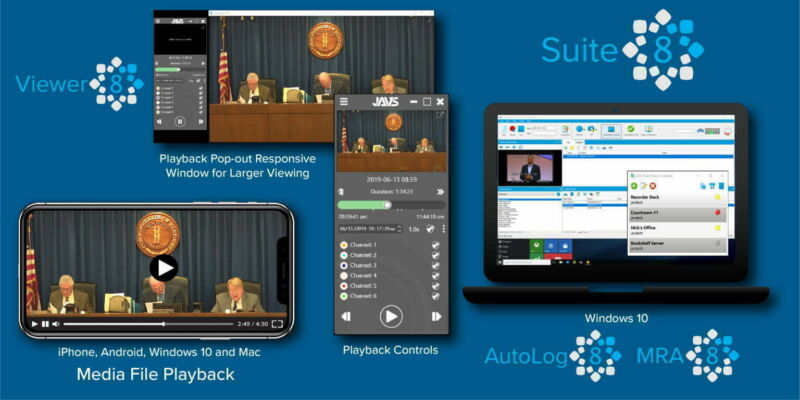A software maker serving more than 10,000 courtrooms throughout the world hosted an application update containing a hidden backdoor that maintained persistent communication with a malicious website, researchers reported Thursday, in the latest episode of a supply-chain attack.
The software, known as the JAVS Viewer 8, is a component of the JAVS Suite 8, an application package courtrooms use to record, play back, and manage audio and video from proceedings. Its maker, Louisville, Kentucky-based Justice AV Solutions, says its products are used in more than 10,000 courtrooms throughout the US and 11 other countries. The company has been in business for 35 years.
JAVS Viewer users at high risk
Researchers from security firm Rapid7 reported that a version of the JAVS Viewer 8 available for download on javs.com contained a backdoor that gave an unknown threat actor persistent access to infected devices. The malicious download, planted inside an executable file that installs the JAVS Viewer version 8.3.7, was available no later than April 1, when a post on X (formerly Twitter) reported it. It’s unclear when the backdoored version was removed from the company’s download page. JAVS representatives didn’t immediately respond to questions sent by email.
“Users who have version 8.3.7 of the JAVS Viewer executable installed are at high risk and should take immediate action,” Rapid7 researchers Ipek Solak, Thomas Elkins, Evan McCann, Matthew Smith, Jake McMahon, Tyler McGraw, Ryan Emmons, Stephen Fewer, and John Fenninger wrote. “This version contains a backdoored installer that allows attackers to gain full control of affected systems.”
The installer file was titled
JAVS Viewer Setup 8.3.7.250-1.exe. When executed, it copied the binary filefffmpeg.exeto the file pathC:\Program Files (x86)\JAVS\Viewer 8\. To bypass security warnings, the installer was digitally signed, but with a signature issued to an entity called “Vanguard Tech Limited” rather than to “Justice AV Solutions Inc.,” the signing entity used to authenticate legitimate JAVS software.
fffmpeg.exe, in turn, used Windows Sockets and WinHTTP to establish communications with a command-and-control server. Once successfully connected,fffmpeg.exesent the server passwords harvested from browsers and data about the compromised host, including hostname, operating system details, processor architecture, program working directory, and the user name.The researchers said
fffmpeg.exealso downloaded the filechrome_installer.exefrom the IP address 45.120.177.178.chrome_installer.exewent on to execute a binary and several Python scripts that were responsible for stealing the passwords saved in browsers.fffmpeg.exeis associated with a known malware family called GateDoor/Rustdoor. The exe file was already flagged by 30 endpoint protection engines.[…]
The researchers warned that the process of disinfecting infected devices will require care. They wrote:
To remediate this issue, affected users should:
- Reimage any endpoints where JAVS Viewer 8.3.7 was installed. Simply uninstalling the software is insufficient, as attackers may have implanted additional backdoors or malware. Re-imaging provides a clean slate.
- Reset credentials for any accounts that were logged into affected endpoints. This includes local accounts on the endpoint itself as well as any remote accounts accessed during the period when JAVS Viewer 8.3.7 was installed. Attackers may have stolen credentials from compromised systems.
- Reset credentials used in web browsers on affected endpoints. Browser sessions may have been hijacked to steal cookies, stored passwords, or other sensitive information.
- Install the latest version of JAVS Viewer (8.3.8 or higher) after re-imaging affected systems. The new version does not contain the backdoor present in 8.3.7.
Completely re-imaging affected endpoints and resetting associated credentials is critical to ensure attackers have not persisted through backdoors or stolen credentials. All organizations running JAVS Viewer 8.3.7 should take these steps immediately to address the compromise.
The Rapid7 post included a statement from JAVS that confirmed that the installer for version 8.3.7 of the JAVS viewer was malicious.
“We pulled all versions of Viewer 8.3.7 from the JAVS website, reset all passwords, and conducted a full internal audit of all JAVS systems,” the statement read. “We confirmed all currently available files on the JAVS.com website are genuine and malware-free. We further verified that no JAVS Source code, certificates, systems, or other software releases were compromised in this incident.”
The statement didn’t explain how the installer became available for download on its site. It also didn’t say if the company retained an outside firm to investigate.
The incident is the latest example of a supply-chain attack, a technique that tampers with a legitimate service or piece of software with the aim of infecting all downstream users. These sorts of attacks are usually carried out by first hacking the provider of the service or software.
Source: Crooks plant backdoor in software used by courtrooms around the world | Ars Technica

Robin Edgar
Organisational Structures | Technology and Science | Military, IT and Lifestyle consultancy | Social, Broadcast & Cross Media | Flying aircraft

